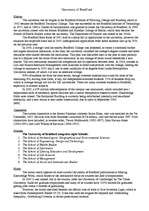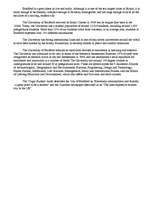-
University of Bradford
History
The university has its origins in the Bradford Schools of Weaving, Design and Building which in 1882 became the Bradford Technical College. This was succeeded by the Bradford Institute of Technology in 1957, and in 1966 a Charter of Incorporation was granted to create the University of Bradford. In 1996 the university joined with the former Bradford and Airedale College of Health, which then became the School of Health Studies within the university. The Department of Physics was closed in the 1980s.
The Bradford Race Riots of 2001 lead to a sharp fall in applications to the university, however the situation has improved since and in 2005 undergraduate applications from home students was up by 35% on the previous year.
In 2003, a merger with the nearby Bradford College was proposed, to create a combined further and higher education institution; at the time, the university validated the college's degree courses and some resources were shared between the institutions. This plan was discarded later in the year at least partially due to a dispute over the name of the new institution, as any change of name would nessesitate a new charter. The two institutions resumed the competition and co-operation between them. In 2004, courses in Law and Human Resource Management were launched in direct competition with the college, leading the college to announce in 2005 that it was to seek validation of its degrees from Leeds Metropolitan University instead, of which it is now an associate college.
94% of students are from the state sector, though overseas students may count for most of the remaining 6%, leaving little room, if any, for independent-schooled students. 15% of students drop out, which is average though not low for UK universities. There are many overseas students at Bradford, especially in science subjects.
In 2005, a £79 million redevelopment of the campus was announced, which included new / replacement halls of residence, sports facilities and a cancer therapeutics research centre. Shearbridge Halls were closed. The Richmond Building is currently being refurbished internally and resurfaced externally, and a new atrium is also under construction, due to open in September 2006.
[edit]
…
A little presentation essay of one of the most famous British universities- the University of Bradford, it's history, chansellor, structure and motto.


